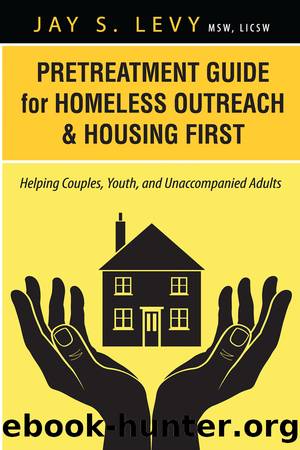Pretreatment Guide for Homeless Outreach Housing First by Jay S. Levy

Author:Jay S. Levy [Levy, Jay S.]
Language: eng
Format: epub
Tags: Political Science, Public Policy, City Planning & Urban Development, Psychology, Psychotherapy, Counseling, Social Science, Social Work
ISBN: 9781615992010
Google: GPkFcnuCdz0C
Publisher: Loving Healing Press
Published: 2012-09-30T05:30:24+00:00
The termination process with Lacey illustrates the redefinition of roles, which allows the outreach counselor to intervene in a highly directed and focused manner upon hearing that she left the Safe Haven Program. It was a very efficient process to find her and address the crisis, while utilizing the opportunity to strengthen her commitment to the Safe Haven and services. This process was facilitated because Lacey understood that the outreach counselor would remain available as a short-term support in case she was to re-experience homelessness, and the outreach counselor understood the limits of his role. It is important to pair the redefinition of roles with an active redirection of the client to appropriate providers or supports that can respond to his or her future requests or needs.
Pretreatment Principles Revisited
Laceyâs narrative illustrates a trauma-informed application of pretreatment principles. The goals of promoting safety, self-care, building supports, and a greater internal sense of control are central to the work. The initial challenge is to promote short-term safety, while progressing through the stages of engagement in an effort to establish trust and a goal driven approach. The counselor used Laceyâs interests and talents to facilitate common language development. These were feeding the birds, reading literature, and sketching. These themes and specific language from her hobbies were used to further the engagement process, while reinforcing her considerable strengths. Throughout the work, the outreach counselor viewed crisis as an opportunity to help Lacey develop some insight and initiative toward her goals of achieving safety and promoting self-care. The counselorâs ecological considerations promoted these transitions by matching Lacey with appropriate supportive programs, and highlighted the need to enhance coping strategies. Lacey developed a toolbox to manage stress, and made some progress in dealing with environmental triggers. This provided Lacey with the internal resources and external supports needed to better manage symptoms and thereby achieve a greater sense of control, rather than being overwhelmed. The key to successful transition hinged on the availability of appropriate resources (Respite and Safe Haven programs) and the outreach workerâs pairing of relationship building activities with well-timed crisis intervention. This gave Lacey the option of being placed in less stimulating environments with critical supports, while letting her know that someone really cared about her. Once Lacey felt safe and supported at the Mental Health Respite, and then again at the Safe Haven Program, she was able to utilize counseling activities that prepared her for future change including treatment and housing options. The outreach counselor understood and framed the termination process as a redefinition of roles. This enabled him to be available when Lacey relapsed, and reduced the risk of her losing well-earned gains.
The standard system of care rigidly defines program admissions and discharges, as well as the specified role of workers in relation to their programs. This could result in a loss of meaningful gains due to relapse and the inability of residential staff to do outreach beyond the programâs boundaries. Also, the opportunities to re-engage individuals who may learn best during periods of crises are nullified.
Download
This site does not store any files on its server. We only index and link to content provided by other sites. Please contact the content providers to delete copyright contents if any and email us, we'll remove relevant links or contents immediately.
Rewire Your Anxious Brain by Catherine M. Pittman(17635)
Talking to Strangers by Malcolm Gladwell(11981)
The Art of Thinking Clearly by Rolf Dobelli(8923)
Mindhunter: Inside the FBI's Elite Serial Crime Unit by John E. Douglas & Mark Olshaker(7893)
Becoming Supernatural by Dr. Joe Dispenza(7159)
Change Your Questions, Change Your Life by Marilee Adams(6702)
The Road Less Traveled by M. Scott Peck(6685)
Nudge - Improving Decisions about Health, Wealth, and Happiness by Thaler Sunstein(6684)
The Lost Art of Listening by Michael P. Nichols(6527)
Enlightenment Now: The Case for Reason, Science, Humanism, and Progress by Steven Pinker(6446)
Win Bigly by Scott Adams(6356)
Mastermind: How to Think Like Sherlock Holmes by Maria Konnikova(6293)
The Way of Zen by Alan W. Watts(5843)
Daring Greatly by Brene Brown(5692)
Big Magic: Creative Living Beyond Fear by Elizabeth Gilbert(4779)
Grit by Angela Duckworth(4775)
Men In Love by Nancy Friday(4381)
Flow by Mihaly Csikszentmihalyi(4093)
The Four Tendencies by Gretchen Rubin(4057)
